Agriculture 4.0 is a new approach towards farm management and precision agriculture using technology, including sensors, smart tools, satellites, the IoT, remote sensing and proximal data gathering.
Sensors empower farmers to react quickly and dynamically maximise crop performance.
Global population growth, global warming, climate change and food security are among the most challenging problems around the world. Farmers need to increase their yields by about 50 per cent by 2050 to be able to feed the world, says Food and Agriculture Organization (FAO) of the United Nations (UN).
As population grows, the amount of cultivable land shrinks. To increase agricultural output from available arable land, one option is to invest in technology to meet the global demand for food. Various stages of the agricultural revolution are aimed at developing new ideas around sustainability, food production, energy and agriculture technologies.
Sensors and digital imaging technologies give farmers a better picture of their fields and crops. Data collected using these prove useful in improving crop yields and efficiency. Development of connectivity with various agricultural tools and sensor technologies lead to important progress in agricultural practice.
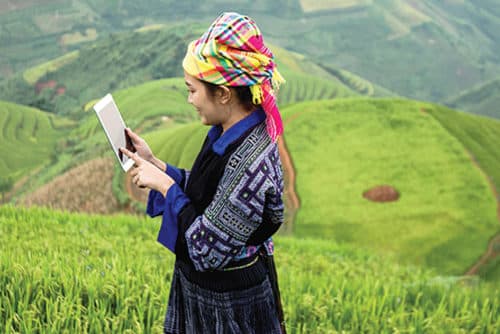
Sensors for agriculture include optical devices, sensors for crop health status determination, seed monitoring, detection of microorganisms and pest management, yield estimation and prediction, detection of crops, weeds and fruits, and airborne, soil, wearable, weather and Internet of Things (IoT) sensors, electronic noses and tongues, sensor networks and so on. This article covers some modern sensor systems used in the agriculture industry, smart farming and environment monitoring systems.
Agriculture 4.0
Agriculture has, for many years, been ignored and remained without modern technology. Now, it is making a big comeback with the use of different technologies. With connectivity gaining ground, we have GPS precision-guided tractors, sensor-based water irrigation systems, pest surveillance from air, smart livestock monitoring along with farmers hooked up to Big Data. We are witnessing agricultural innovation and adapting to a changing world and new settings including digital precision and smart farming.
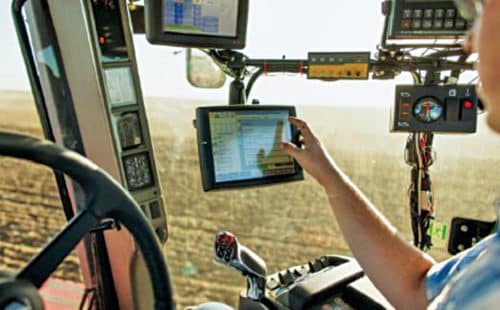
Agriculture 4.0 is a new approach towards farm management and precision agriculture using technology, including sensors, smart tools, satellites, the IoT, remote sensing and proximal data gathering. It is about connectivity, smart agriculture or digital farming, in addition to the integrated internal and external networking of farm operations.
Agriculture 4.0 is said to have started around early 2010s, with low-cost and improved sensors, actuators, microprocessors, nanotechnology, high-bandwidth cellular communication, cloud computing and artificial intelligence (AI).
Smart farming
While precision farming was mainly based on the use of GPS sensors for auto-steering of tractors and harvesters, the focus of smart farming has now shifted towards smart treatments like deciding the amount of fertiliser that should be applied, or using plant protection resources for optimal crop development in a particular area in the field.
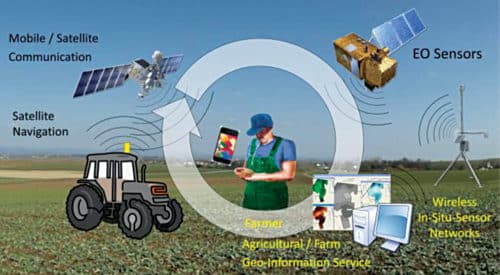
Data- and information-driven agriculture is a general trend in smart farming. Earth observation (EO) and navigation satellites use data collected from ground sensors to help farmers decide how, when and where to allocate resources for best results.
Satellites are mounted with multiple sensors. Information on current growth status and development of crops at each location in the field is obtained from the satellite(s) through various plant conditions and parameters such as biomass and chlorophyll content during growing season. Such data help farmers update crop status for specific plant protection and fertilisation measures. Farmers can also monitor various parameters on smartphones or tablets on-the-go.
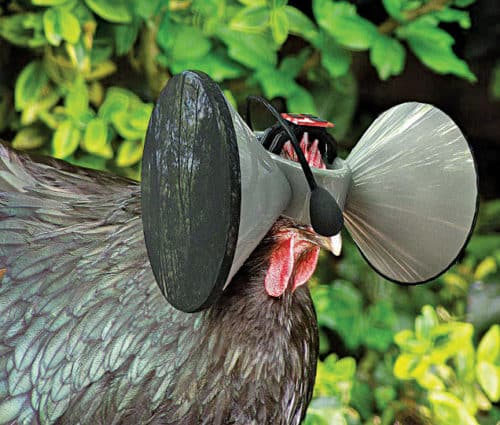
Cognitive sensing technology
Precision farming can be enhanced using cognitive sensing technology. For example, IBM Watson can adapt to consider new parameters and uncover correlations between various parameters, using machine learning.
A cognitive system with advanced sensor technology provides real-time feedback like temperature, humidity, light, soil pH, precipitation, irrigation timing and so on. It can help identify actual problems affecting the crops. Cloud-based services with a cognitive system learn from results all around the world in real time, so that each season brings better insights, solutions and recommendations for better yields.
Smart spraying technology
To combat weeds and undesired plants that affect crops, herbicides are applied over large surface areas, covering crops and fields. Bosch and Bayer are developing smart spraying technology that uses camera sensors to distinguish between weeds and crops. This way only weeds are targeted, and crops and the environment are protected.
Plant-specific herbicide application requires sensor systems for plant recognition and differentiation. However, it is not easy to recognise small weeds in the early stages of development. With modern technology, programmable true-colour sensors can be used for real-time recognition and identification of individual weeds and crops. This can be achieved by collecting data based on the reflection properties of plants, and natural and artificial backgrounds. Crops and weeds are recognised using mathematical algorithms and decision models based on such data.
The IoT for agriculture
The IoT for agriculture, or IoT4Ag, is a new area of technology that holds tremendous potential for improving global food production. IoT sensors can be deployed on the ground or in water to collect data on target inputs, such as soil moisture and crop health. Collected data are stored on a server or cloud system wirelessly, and can be easily accessed by farmers via the Internet on tablets and cellphones.
IoT applications include farm vehicle tracking and livestock monitoring, and in arable farming, agri-food supply chain, green house monitoring and other farm operations. Farmers can remotely control activities in the farm through connectivity options like Nano Ganesh, which is a mobile-based remote controller for water pumps.
There are IoT devices from Smart Elements, wherein a variety of sensors are deployed in a farm that report back to an online dashboard. Farmers need not visit the farm, thus saving time and money by making fast and informed decisions based on real-time conditions.
Adoption of IoT solutions for agriculture is constantly growing. Cellular companies are seeking business opportunities in farm IoT applications. They are developing integrated systems that combine sensors and communication systems. IoT sensors and cloud computing will drastically improve the quality of data flow, which will, in turn, help farmers make better decisions.
Digital livestock farming
As population increases, demand for milk and meat also increases. Digital and sensor technologies are being deployed in livestock management. Precision livestock farming uses advanced technologies, such as microfluidics, sound analysers, image-detection techniques, sweat and saliva sensing, serodiagnosis and others, to optimise the contribution of each animal.
Smarter production, proper nutrition as well as increased animal welfare have the potential to decrease the impact of livestock farming on resources. Many companies are working on the welfare of livestock animals, while others are working on animal health management.
With such technology, livestock such as chickens are treated as humanely as possible. Computer interfaces and virtual environments are combined to meet the needs and desires of each animal species. Enclosures are built to provide a comfortable and healthy home. The system provides livestock with the freedom to move freely in the virtual world, providing them with better treatment than they would be in the real world. Each enclosure is filled with independently filtered air to keep communicable diseases and parasites from spreading throughout the facility.
Biosensors are being used for animal health management. New wearable technologies, such as tracking collars and electronic saddles, are being used in animals, pets and livestock for their healthier upbringing. With the help of IoT-based movement sensors and microphones, farm owners can check the well-being and location of their livestock through smartphones.
Agricultural drones
Drones with such sensors as thermal, camera, lidar and multispectral are bringing major benefits to the agricultural industry. Agricultural drones with sensors allow farmers to see their fields from the sky. Information and data collected from the drones reveal such issues as irrigation problems, soil variation, and pest and fungal infestations. The difference between healthy and unhealthy plants is sometimes difficult to detect with naked eyes. Multispectral images can assist in differentiating between healthy and unhealthy plants, and enable farmers to take timely actions.
Many companies are manufacturing drones for agricultural applications. For example, advanced autopilot drone from Drotek features advanced processors and latest sensor arrays working with a real-time operating system that can deliver incredible performance.
DJI manufactures a variety of high-tech drones. Agras MG-1S, also called the wonder drone, from DJI is a highly-advanced drone spraying system that has GPS, flow sensors, triple radar sensors and fully-programmable flight paths. Agras octocopter is designed for precision variable rate application of liquid pesticides, fertilisers and herbicides with good efficiency and manageability.
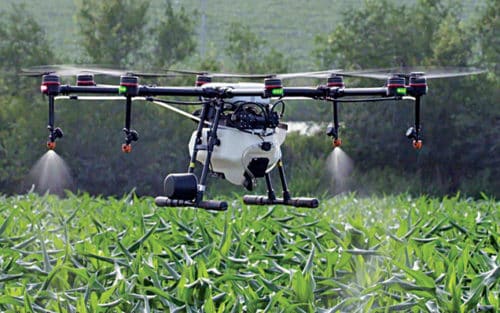
Multispectral imaging system
Multispectral sensors collect visible (red, green and blue) wavelengths as well as infrared (IR) radiation and ultraviolet (UV) light. These are used to monitor plant health, identify deficiencies and pest damage, optimise fertilisation and assess water quality.
Sentera manufactures sensors to capture precise, radiometrically-accurate plant-level vegetative indices. The double 4K sensor from Sentera can easily integrate onto drones. The sensor collects visual-band imagery, multispectral images as well as vegetation indices, including normalised difference vegetation index (NDVI) or normalised difference vegetation red edge (NDRE) data. It helps agronomists and farmers identify crop health issues with greater precision.
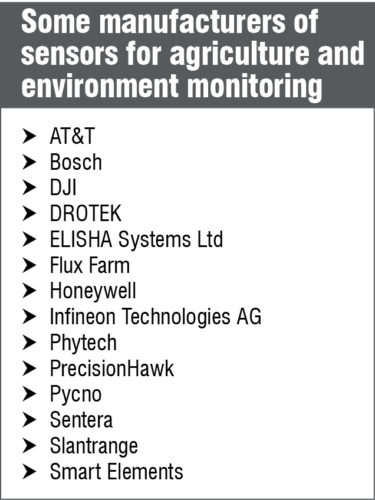
AI for farming
China and India are speeding up efforts in artificial intelligence (AI) innovation and development to assist farmers in planting decisions and crop protection. AI holds the promise of driving the agricultural revolution to produce more food using fewer resources. An AI system using Big Data management technologies and cloud computing aims to provide effective decision making for farmers.
Sensors monitor a fruit’s progress in terms of perfect ripeness, adjusting light to accelerate or slow down the pace of maturation. This kind of farming requires considerable processing power. Intel’s Xeon processors are being used to power AI algorithms.
Smart algorithms are applied to agricultural technologies to enable them to learn and teach themselves. AI and smart algorithms can analyse massive amounts of data on weather, environmental and historical information to make increasingly accurate predictions on what, where, when and how to plant crops for optimal performance and yields. There is great potential of AI combined with IoT4Ag.
Some smart agricultural sensors
Flux.IoT Eddy robot built with wireless sensors and image processing technology tells farmers specifics about their hydroponics and other indoor growing systems. It can monitor variables such as pH levels, temperature and relative humidity. It can also detect contaminants and provide information on how to resolve such problems.
Pycno’s plug-and-play sensors with solar panels are fully-autonomous, having a simple dashboard. These allow seamless data collection and transfer from the farm to the smartphone.
Amber Agriculture smart sensor technology provides analytic solutions for the grain industry. Wireless pellet sensors distributed with the grain in storage bins or containers monitor such internal conditions as temperature, humidity and volatile compounds.
Acuity Agriculture wireless field sensors allow farmers to monitor soil conditions and pest development, schedule irrigation events, track climate conditions and predict harvest timings.
Phytech smart sensors placed directly on plants and crops can monitor the micro-variations of stem diameters to provide stress indications.
Slantrange sensor and analytic systems are used on drone aircraft to measure crop and weed densities, stress from pest infestations, nutrient deficiencies and dehydration levels.
Environmental monitoring sensors
Climate and weather are the top influencing factors in the production of crops. Sensors are getting ubiquitous and playing an important role in sensing the environment. These include sensors for monitoring water, air, weather and soil.
Barometric sensors are used in weather networks. Infineon Technologies manufactures barometric pressure sensors for mobile and wearable devices having high precision and low power consumption. For example, their DPS310 barometric pressure sensor is recommended for applications where power consumption is critical and highest precision in pressure metering is required.
With an IoT-enabled weather monitoring system, farmers can determine the optimum time for plantation, irrigation and harvesting. Predictive weather models are constructed using sensors in IoT applications. Based on sensor data, farmers can plan and change harvest and irrigation times to improve the crops. By organising and analysing collected data, they can take pre-emptive actions for healthy harvest of their crops.
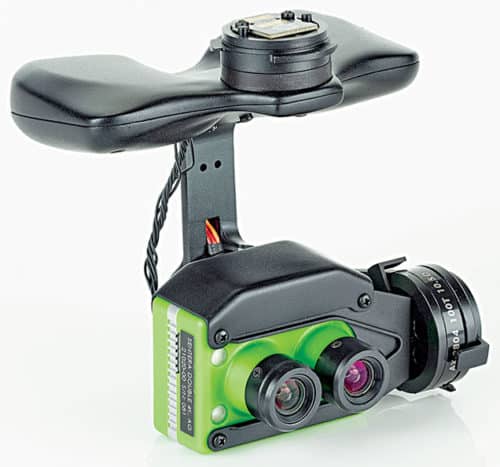
To sum up
We are entering the era of Agriculture 4.0, which is a new phase of the agriculture revolution. We are witnessing precision, smart and digital farming using various modern technologies. Recent technology trends include sensors for connected livestock, satellites, the IoT and GPS sensors, among others, to measure a variety of essential soil and plant properties on-the-go.
Scanning from the sky using drones attached with camera sensors to monitor the fields, and also monitoring from anywhere using the Internet and IoT sensors, farmers can access various information related to real-time sensing of soil and crops.
AI with modern sensors can be used to adapt strategies to the changing conditions of the field and environment. Sensors empower farmers to react quickly and dynamically maximise crop performance, resulting in better yields and higher food productivity.










